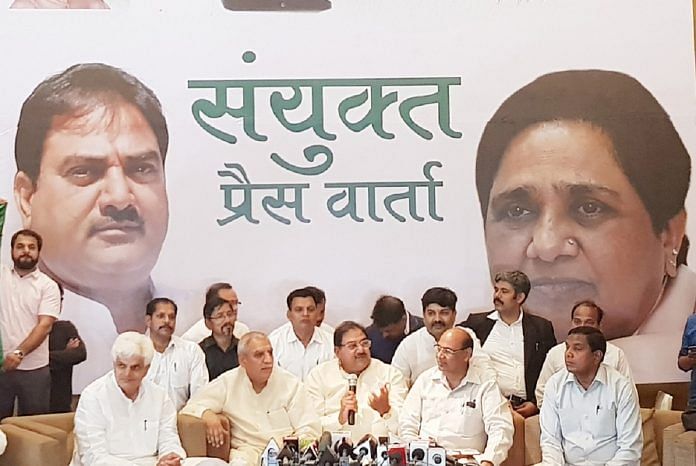The Jat-dominated INLD has been out of power in the state for the past three terms, its chief, five-time CM O.P. Chautala, is serving jail term in a graft case.
Chandigarh: BSP supremo Mayawati has stitched up an unconventional Jat-Dalit alliance for the coming Lok Sabha and assembly elections in Haryana, due next year. The move is seen as her return to the “social engineering” experiment, first successfully carried out in the 2002 UP elections.
The Jat-dominated Indian National Lok Dal (INLD) joined hands with BSP — a party mainly of Dalits — last week with INLD leader Abhay Chautala terming it as the “launch of the third front” in national politics.
The INLD has been out of power in the state for the past three terms and its chief, five-time chief minister Om Prakash Chautala, has been serving his jail term since 2013, along with elder son Ajay, following conviction in a teacher recruitment scam.
The BSP with a vote base of almost 20 per cent in Haryana, has managed to win only one seat each in the 2014 and 2009 assembly elections.
The two parties had earlier come together for the 1998 Lok Sabha polls but separated before the assembly election.
Chautala’s younger son, Abhay, who is now the face of the beleaguered party, announced the bond with the BSP in a joint press conference with Dr Meghraj, BSP’s regional incharge, Wednesday. Terming the new tie as “raksha bandhan”, Abhay Chautala called it the “launch” of the third front in the country, projecting Mayawati as the PM candidate.
No deal with Congress
When asked, Chautala made it clear that Congress will not be a part of this third front while Dr Meghraj avoided any concrete reply to the question.
The coming together of the two parties may not hold much significance on the national electoral scene. The alliance, however, seems to be the outcome of a shrewd calculation on part of the two parties to push one another in the assembly polls, to be held a few months after the general elections next year.
Although Abhay Chautala did not immediately disclose the seat sharing formula between the two parties, the move is going to impact the fortunes of the INLD in at least 20 constituencies in the 90-seat assembly.
Past alliance with BJP
Alliances have brought mixed results for INLD. Its bond with the BJP (as part of the NDA) ahead of the 1999 Lok Sabha elections led to the alliance winning all the 10 seats, five each by both the parties. In the 2000 assembly polls, it shared 29 seats with BJP and came to power winning 47 seats out of the 62 it contested while BJP won six seats.
The INLD-BJP alliance broke immediately after the Lok Sabha elections in 2004 when INLD won no seat and BJP won a single seat. The two came together again for the 2009 general elections but were routed at the hustings, leading to the breaking of the ties again. In 2014 Lok Sabha elections, INLD won two of the 10 seats.
Then it suffered a huge defeat at the hands of the Congress led by Bhupinder Singh Hooda in 2005 — INLD’s seat tally came down to only nine. In 2009, Hooda repeated his victory with 40 seats but INLD too had bounced back into the game with 31 seats.
In the last assembly elections in 2014, BJP’s surprise win of 47 seats left the INLD with 19 seats and the Congress with 15.
Even in its consecutive defeats, the INLD which caters mainly to the Jat rural vote bank, has retained more than 25 per cent, an almost fixed vote share, in the state. The BSP’s vote share in the past four elections ranged between 4 and 7 per cent.
INLD’s traditional partner (only for assembly election) — the Shiromani Akali Dal (SAD) — managed to get another 1 per cent.
In the last elections, BJP had bagged almost 33.20 per cent votes while the Congress got 20.58 per cent and the INLD 24.11 per cent votes. BSP candidates contested in 87 out of 90 seats and won only one seat at Prithla. The vote share of the party was 4.37 per cent.
Why BSP?
The INLD leadership feels that an alliance with the BSP in the last polls could have led them to victory. In 40 seats, the INLD was the runner-up party. Of these, in at least 16 seats, including some reserved ones such as Mulana, Shahbad and Sadhaura, the BSP had secured enough votes to help INLD candidates win.
In another three seats — Jagadhri, Assandh and Naraingarh — the BSP was in a strong position and a push from the INLD was all they needed to win.
The BJP’s major share of votes came from the seats falling in the GT Road and Southern Haryana.
In the 2009 polls, when INLD lost to the Congress, its vote share was 26.5 per cent. The Congress came to power with over 35 per cent vote share. BSP had managed to secure more than 7 per cent of the vote share in Sohna, Punahana and Prithla.
The party also did well in Naraingarh, Mulana, Sadhaura, Radaur, Kalayat, Kaithal and Gharaunda.
New plan
The INLD and the BSP declared that they will jointly organise the jail bharo andolan on 1 May to press for the construction of the Sutlej Yamuna Link canal to bring Haryana’s share of river water to the state.



